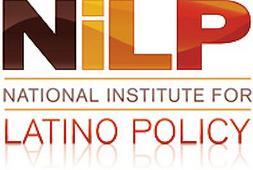
NiLP Latino Datanote
Continued Latino Underrepresentation in the New York City Government Workforce: 2017
By Angelo Falcón
The NiLP Report
CONTENTS
 After four years of the NYC Mayor Bill de Blasio Administration, the degree of Latino underrepresentation
in the city's has remained the same despite repeated attempts to get
the Mayor to address this long-term problem. The city's latest employment
data, the
2017 EEO-4 report, shows that Latinos make up only 19.7 percent of the municipal workforce,
despite making up 27.2 percent of the city's overall labor force.
This has significant implications for the failure for creating a sufficiently
large middle class in the city's Latino community.
After four years of the NYC Mayor Bill de Blasio Administration, the degree of Latino underrepresentation
in the city's has remained the same despite repeated attempts to get
the Mayor to address this long-term problem. The city's latest employment
data, the
2017 EEO-4 report, shows that Latinos make up only 19.7 percent of the municipal workforce,
despite making up 27.2 percent of the city's overall labor force.
This has significant implications for the failure for creating a sufficiently
large middle class in the city's Latino community.
Latinos in New York City currently number 2,489,090, or 29.2 percent of the total population.It is a larger population than that of Blacks (22,2 percent) and Asians (13.6 percent), and slightly smaller than Whites (32.3 percent). The majority are of Caribbean descent (Puerto Rican and Dominican), followed by Mexicans, Ecuadorians, and Colombians. Close to 40 percent have some college or above, and have a median age of 33 years compared to 36 years for the total population. Latinos have a per capita income of only $19,718, compared to $35,508 for the city as a whole. While the citywide official poverty rate of 18.9 percent, for Latinos it is 26.6 percent.
As the low level of Latino local government employment remains that same over the years, the Latino share of the city's overall labor force continues to grow, making the underrepresentation gap larger as time goes on. In 2017, Latinos still made up only 20.3 percent of municipal government new hires, making it clear that the city government's employment diversity programs are not reaching the Latino community. Their effectiveness needs to be reassessed by the Mayor and City Council.
Since the Bloomberg Administration, the city's bi-annual EEO-4 reports on the racial-ethnic breakdown of the municipal workforce are presented in a format that is difficult to analyze. Also, instead of providing data for individual agencies it groups them into broader "functional codes" that makes the data less useful for accountability. For example, under "Financial Administration and General Control" are 60 agencies including the Office of the Mayor, and under "Other" is the City Council.
These 2017 EEO-4 data present the following breakdowns that NiLP was able to compile after digitizing and recalculating the report data. The EEO-4 report also includes data on job categories and salaries, but in this NiLP Latino Datanote, we concentrate on overall employment composition and new hires by racial-ethnic group and functional category.
Please note that the EEO-4 report does not include all city agencies, such as the Department of Education and NYCHA. The functional codes used in the report include the following agencies:
- Community Development (City Planning, and Landmark reservation Commission)
- Corrections (Board of Correction, Department of Correction, and Probation)
- Financial Administration and General Control (includes 50 agencies and offices, such as Office of the Mayor)
- Fire Protection (Fire Department)
- Health (Health and Mental Hygiene, Health and Hospitals)
- Housing (Department of Buildings, and Housing Preservation & Development)
- Natural Resources, Parks and Recreation (Department of Parks & Recreation)
- Police Protection (Police Department and the Office of Emergency Management)
- Public Welfare (Office of Homeless Services, Social Services/HRA and Youth and Community Development)
- Sanitation and Sewage (Department of Environmental Protection, and Sanitation)
- Utilities and Transportation (Department of Transportation)
- Other Agencies (City Council, Department of Design & Construction, and Independent Budget Office)
Racial-Ethnic Breakdown
of Municipal Workforce. As already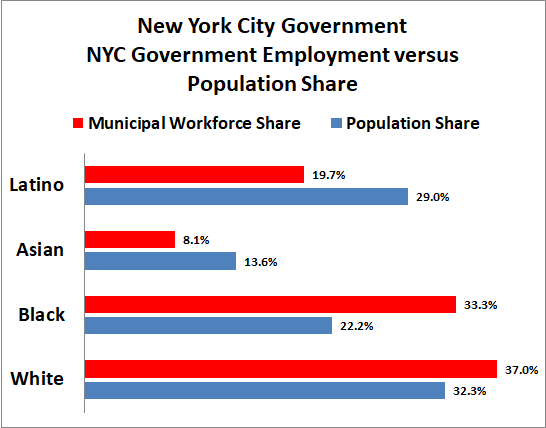 mentioned, Latinos make up 19.7 percent of New York City government employment.
This is in comparison to 37.0 percent of Whites. 33.3 percent of Blacks
and 8.1 percent of Asians. Comparing these percentages to the overall
population share of these groups, the most overrepresented in city government
employment are Blacks (by +50 percent), and Whites (by +15 percent), and
the most underrepresented are Asians (by -40 percent) and Latinos (by
-32 percent). This comparison with the population is presented not to
advocate for quotas but merely to present the degree of overall disparities
that exist.
mentioned, Latinos make up 19.7 percent of New York City government employment.
This is in comparison to 37.0 percent of Whites. 33.3 percent of Blacks
and 8.1 percent of Asians. Comparing these percentages to the overall
population share of these groups, the most overrepresented in city government
employment are Blacks (by +50 percent), and Whites (by +15 percent), and
the most underrepresented are Asians (by -40 percent) and Latinos (by
-32 percent). This comparison with the population is presented not to
advocate for quotas but merely to present the degree of overall disparities
that exist.
Latinos are best represented in the following functional agency categories: Police Protection (24.4 percent), Natural Resources (Parks) (22.0 percent), Corrections (20.9 percent). Public Welfare (17.7 percent), Financial Administration (17.2 percent) and Health (17.2 percent). Latinos are least represented in the following areas: Community Development (12.9 percent), Transportation (14.9 percent), Other (including City Council) (15.5 percent), Fire Protection (15.8 percent), Housing (16.9 percent) and Sanitation and Sewage (17.0 percent).
While all of these functional categories are either predominantly White or Black, none are Latino or Asian because of their underrepresentation. The areas where Whites are most represented are Fire Protection (67.1 percent), Community Development (56.2 percent), Sanitization and Sewage (52.4 percent), and Utilities and Transportation (44.0 percent). The areas where Blacks predominate are Public Welfare (59.9 percent), Corrections (59.2 percent), Health 42.1 percent) and Housing (38.3 percent).
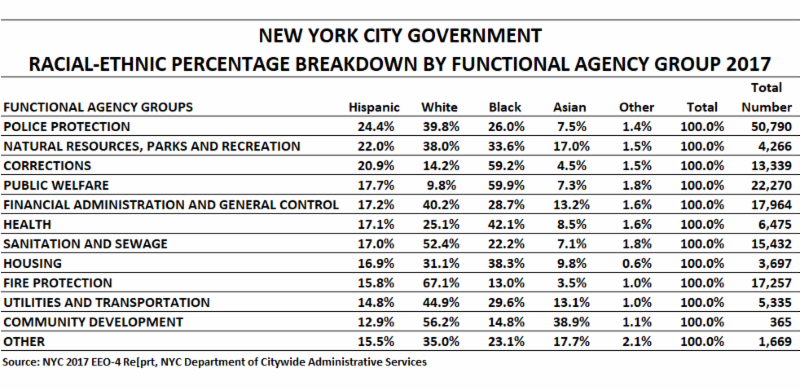
To get a picture of Latino employment participation in areas other than Police Protection, we eliminated this category from our analysis. The result is that without Police Protection included, the Latino shared of the municipal workforce drops from 19.7 to 17.4 percent. By doing so, the municipal employment percentage also goes down for Whites (37.0 to 35.3 percent), increases for Blacks (33.3 to 36.3 percent) and remains about the same for Asians (8.1 to 8.3 percent).
Racial-Ethnic Distribution. Regarding distribution among these functional areas, Latinos are most concentrated in Police Protection, which employs 39.6 percent of all Latinos working for city government. With Police Protection employment making up 32.0 percent of the entire municipal workforce, Latinos are the group most concentrated in this functional group. The next highest concentration in this Police Protection category is among Whites (34.4 percent), followed by Asians (29.6 percent) and Blacks (25.0 percent).
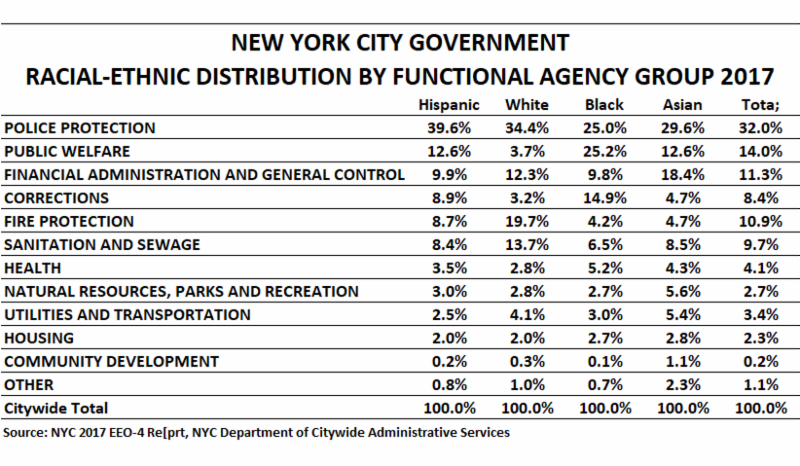
Gender Distribution. Latina women made up 39.1 percent of all Latino municipal employees. This percentage was only exceeded by Black women, who were in the majority (58.3 percent) of total Black employees. There was a smaller percentage of women employees among Whites (18.9 percent) and Asians (27.5 percent).
Latinas were best represented in the following functional areas: Public Welfare (12.8 percent), Health (11.6 percent), and Financial Administration (9.3 percent). Latino men were best represented in the following areas: Police Protection (16.4 percent), Sanitation and Sewage (14.5 percent), Natural Resources (13.6 percent), Corrections (13.2 percent) and Fire Protection (13.1 percent).
More than two-thirds of Latina women were concentrated in two areas: Police Protection (33.3 percent), Public Welfare (23.2 percent) and Financial Administration (13.7 percent). About two-thirds of Latino men were employed in Police Protection (43.6 percent), Fire Protection (11.8 percent) and Sanitation and Sewage (11.7 percent).

New Hires. Despite being underrepresented in the municipal workforce, representing 20 percent of the total, they also represented only 20 percent of new hires. This means that the status quo will continue until the rate of Latino new hires increases significantly in the years to come. This percentage of the total of new hires was exceeded by those of Blacks (33.8 percent of the total) and Whites (21.1 percent). Asians made up 12.6 percent of all new hires, although they are 14.5 percent of the city's overall labor force.
The highest percentages of new hires were in the following functional areas: Police Protection (25.4 percentages). Corrections (24.8 percent), Natural Resources (22.0 percent). and Other (20.8 percent).
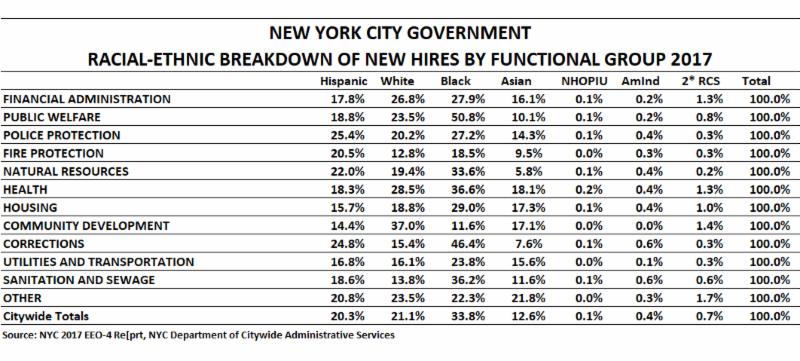
Summary of Issues. This analysis of Latino employment in New York City government reveals the following issues:
- Latino underrepresentation in the municipal workforce remains a problem, and the data on new hires indicates that the de Blasio Administration is not addressing the problem. We estimate that this underrepresentation represents a loss of close to a billion dollars a year to the Latino community from just salaries (not including benefits).
- The majority (52 percent) of Latino city employees are overly concentrated in only two functional areas: Police Protection and Public Welfare. This is similar to Blacks (50 percent) and greater than that of Whites and (38 percent) Asians (42 percent) concentrations in the same two areas.
- If Police Protection is removed from the analysis, the Latino percentage of the municipal workforce drops to 17.4 percent. This means that Latino underrepresentation increases in other areas of municipal activity also vital to Latino community needs like housing and economic development.
- City agencies remain racially segregated, with the existence of predominantly White and Black agencies. This has created a problem of racial gatekeeper networks from which Latinos have experienced degrees of employment discrimination regarding hiring and promotions.
- Black overrepresentation in the municipal workforce indicates that it is possible to address employment discrimination in the municipal workforce, at least in lower levels of employment. However, Black progress in this area was the result of long-term effects of the historic Civil Rights movement. No similar movement has existed that focused on the Latino community.
- The concentration of Latinos in Police Protection contrasts with the lower concentration of Blacks in this area. This appears to be the result of different general attitudes to the police in these communities.
- The Latino concentration in the Police Protection area at the level of a police officer and civilian police employees now raises the issue of Latino promotions within the Police Department.
- The majority of Latino municipal employees are men, as it the case with Whites and Asians. This is in contrast with Blacks, where women are in the majority.
- Both Latino men and women were overly concentrated (67-70 percent) in three functional areas. While the highest concertation for both was Police Protection, for women the other two were Health and Financial Administration, while for the men it was Fire Protection, and Sanitation and Sewage.
Recommendations for Change. These recommendations were first presented to Mayor de Blasio in a May 19, 2014, memo. Since that date, NiLP has continuously sought to get a response from the de Blasio Administration to the suggestions made below to begin a serious dialogue about how best to address this problem of Latino underrepresentation in city government.
The long-term underutilization of Latinos in the municipal work force indicates that the city government's diversity mechanisms and processes have not been working when it comes to the Latino community. There is an urgent need to reassess the city's workforce diversity efforts as they relate to the Latinos as well as newly-emerging communities.
Through these recommendations, our purpose is to address these goals:
- Increase the representation of Latinos at all levels of and across all agencies of city government until we at least reach parity with our community's representation in the civilian labor force of the city.
- Develop a mechanism for the coordination of these efforts and provide accountability to the Latino community.
- Promote a critical review of current equal employment opportunity policies and procedures to develop more effective approaches to promoting greater Latino inclusion in the city government workforce.
- Increase the transparency of city government's efforts at Latino inclusion in the municipal workforce and its overall equal employment opportunity programs, policies, and data.
- Develop a robust pipeline of Latino talent that can be recruited and hired by the city government.
- Develop incentives for city managers for more aggressively and creatively promoting workforce diversity in their agencies.
Regarding the city's workforce diversity program, we recommend the following
1. Create a Latino Diversity Task Force under the leadership of the Deputy Mayor for Health and Human Services to oversee the development of new approaches to Latino inclusion in the de Blasio Administration and provide the mayor and his top staff with ongoing feedback on progress being made in this area.
2. A critical review of the role of the key diversity agencies is long overdue: the Department of Citywide Administration Services, the Equal Employment Practices Commission, the Commission on Human Rights and the Civil Service Commission. It has become clear that the city's diversity programs have become much too passive, defensive operations and do not have the authority or mission to promote aggressively workforce diversity. Links are provided above to letters sent to agencies we outreached to outlining issues specific to each concerning Latino employment issues.
Here is an organizational chart of these agencies:
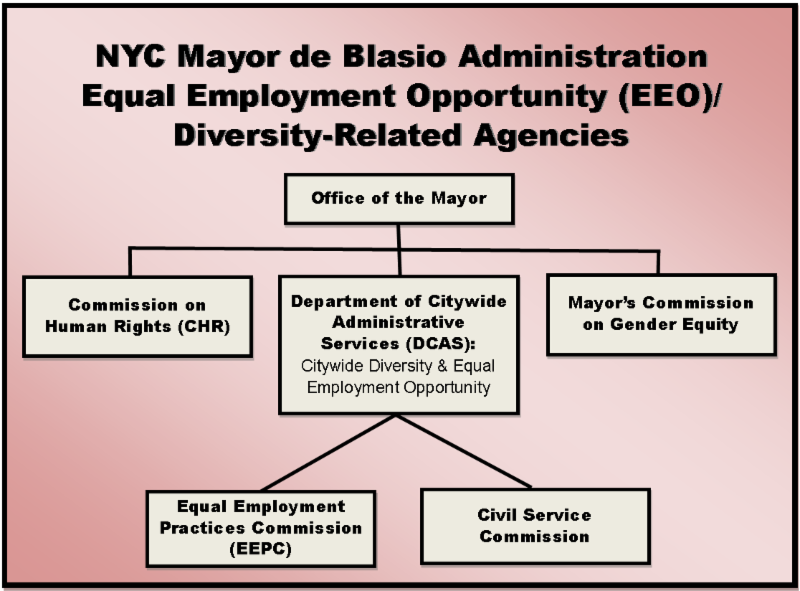
3. The diversity workforce data and plans of each agency should be made transparent both centrally and for each agency individually. We recommend that the city mandate that each city agency, board, and commission provide both EEO data and the diversity plans on each of their websites on an annual basis to increase their accountability on this issue.
We recommend that the city's biennial EEO-4 reports be issued annually and revamped for greater transparency and usefulness. This would include providing employment data for all city agencies, including the Department of Education, NYCHA, and others currently excluded, and eliminate the use of the overly general, useless and confusing functional codes currently being used. These reports should also be provided in spreadsheet format to allow for the independent analysis of the data provided.
4. Each agency commissioner and head should be made responsible for developing plans for the desegregation of their agencies and to promote the full diversity of their workforces.
a. Each head of a city agency should be required to hold a major meeting with their agencies; major Latino stakeholders to discuss Latino community concerns about staffing, resource allocation and other issues.
b. Each city agency should be required to establish employee affinity groups for Latinos and other protected classes, and a citywide coordinating body of these groups based in the Mayor's Office.
5. The promotion of workforce diversity should be made a core value of the de Blasio Administration, and its' managers should receive incentives for the progress they make in this area. As recognition of the importance of diversity for the Administration, we recommend that it be added as an indicator in the annual Mayor's Management Report.
6. Serious attention needs to be given to pipeline development issues for Latinos coming into the city government's workforce. We recommend that an inventory is developed of the various internship, fellowship and related programs that seek to develop and recruit new talent to see how they have been utilizing Latinos. Are existing programs doing an adequate job? Do they need to be reorganized, or new programs be recruited? Is the city fully utilizing the potential role that the City University of New York and the Department of Education can play in promoting public service among the city's Latino youth?
Many of these recommendations were developed as a result of a meeting held with various city officials and agencies, as well as Latino community leaders and advocates. We think they represent a good starting point for reversing the more than two decades of Latino marginalization from the municipal workforce and policymaking process. While the hope is that Mayor de Blasio will finally address these issues directly, we also expect the City Council under its new Speaker, Corey Johnson, to also play an important role.
Angelo Falcón is President of teh National Institute for Latino Policy (NiLP). He can be reached at afalcon@latinopolicy.org.
_______________________________________________________________________________________________________

